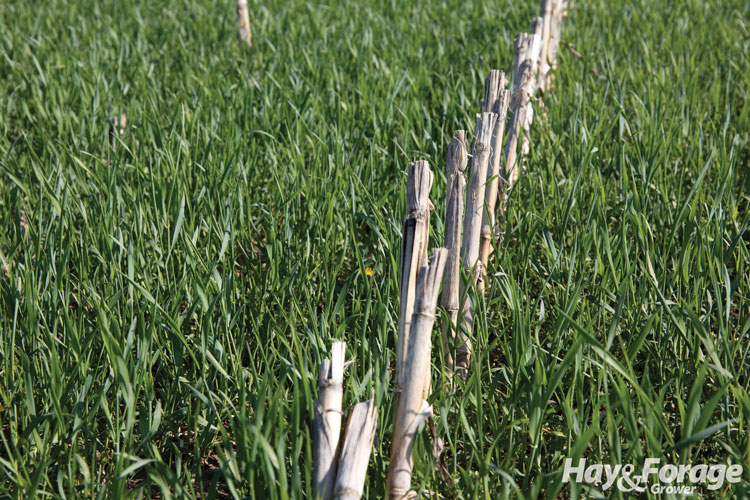The author is a rancher, author, speaker, and consultant with over 40 years of experience in grazing management research, outreach, and practice. He has lived and grazed livestock in hot, humid Missouri and cold, dry Idaho.

This past fall, I had the opportunity to visit several different regions across the U.S. and drove many miles of two-lane roads around the countryside. Cover crops came to my attention in different ways in different places. In several locations, it was clear that the number of acres with cover crops seeded following harvest had jumped substantially from the last time I had visited. I viewed this as a positive advancement. Many of these cover crop fields had electric fences around them, and cattle and sheep were grazing the cover crops.
In other locations, there were what I would call “accidental” cover crops. These are volunteer crops coming up in areas that had received fall rains. I look at those volunteer plants coming up and see all the positives of cover crops: a living plant root in the soil more days of the year, which is beneficial for enhancing soil biology and plant-soil-water relationships; protection on the soil from wind and water erosion; and grazing opportunities for livestock on cropland.
Sadly, what I saw in many locations were farmers doing fall tillage to get rid of those beneficial volunteer plant covers. Sometimes, I just don’t understand why. We have one segment of the farming population paying money to create cover crops on their fields while we simultaneously see farmers spending money to destroy any living plant on their fields. It is a conundrum.
Foiled by blowing soil
On the Snake River Plains of southern Idaho, the wind blows frequently and steadily. Above average precipitation in August and September had brought beautiful cover crops of volunteer barley and wheat on recently harvested fields. I drove past many acres of volunteer small grains where no dust clouds wisped across the landscape.
Then I came to the field where the farmer was disking it into oblivion with a massive cloud of dust rising behind the tillage tool. There are signs along Interstate 15 warning drivers of potential blowing dust and ordering motorists not to stop in the traffic lane. Why do we have to have signs like that near Idaho Falls?
These are all irrigated crop fields that are moist and stable in the growing season when the crops are growing. Once the irrigation is turned off and the crops harvested, fall tillage begins, resulting in massive dust storms sweeping across the landscape. I have been in those dust storms a number of times over the last 20 years, creeping along the interstate at 30 miles per hour because that is all the visibility will allow. It’s hard to understand why farmers willingly allow their topsoil to blow away year after year.
I saw a similar situation in the Midwest. On one side of the road, corn stubble had been deliberately overseeded with a small grain-brassica cover crop. On the opposite side of the road, a beautiful stand of volunteer corn had come up. It was almost knee-high and quite uniform across most of the field as the farmer was disking it down. Perhaps the farmer had no cattle, but I know he had a neighbor who would have been willing to rent that field for grazing. How is it that two farmers with nothing more than a gravel road separating them have such different views on the value of a cover crop?
Comes at a cost
The average custom farming rate for disking in that Midwest state was $22 per acre in 2023. That’s what it cost the one farmer to get rid of his volunteer corn. On the day I looked at that field in October, I estimated there would have been at least 30 animal unit days per acre (AUD/A) of grazing. The neighbor would have happily paid $21 per acre to graze that volunteer corn at a cost of 70¢ per AUD. The farmer without a cover crop could have been $43 per acre ahead by letting his neighbor terminate the corn crop with grazing (added income $21 per acre) rather than doing the disking (added cost $22 per acre). Further, the soil would not have been disturbed and left vulnerable to wind and water erosion.
Seeding a cover crop may range from as little as $25 per acre to over $100 per acre, depending on the composition of the mix and the seeding method. I have to admit I was surprised to see the density of some of those volunteer cover crops. Modern harvesting equipment should be doing a better job than what I was seeing. Perhaps there were unique circumstances last fall that led to such beautiful volunteer cover crops. Maybe year-to-year consistency doesn’t really happen.
In any case, being opportunistic and taking advantage of volunteer plants when they occur is a reasonable strategy for most farmers. At the very least, we shouldn’t be spending money to get rid of volunteer stands through land-degrading tillage.
This article appeared in the January 2024 issue of Hay & Forage Grower on page 21.
Not a subscriber? Click to get the print magazine.

